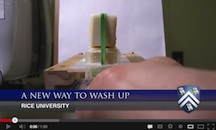One grate idea leads to another
Rice University freshmen create unique soap dispenser for washing up at Houston restaurant
HOUSTON – (April 3, 2013) – Diners at a downtown Houston restaurant will soon have to pause and think about a process they all too often take for granted when they wash their hands.
Instead of a common wall-mounted dispenser spitting out runny glop, a device built around a real kitchen grater will serve up flakes from a high-quality bar of soap. Patrons will find they have to scrub, scrub, scrub to lather up and get clean.
That’s by design. They’ll be doing the bidding of a group of Rice University freshman engineering students who are creating a set of unique soap graters for the women’s and men’s restrooms at the restaurant’s request.
The eatery, The Pass and Provisions, turned to a Rice faculty member last year for a design that would fit its aesthetic. Five students who cheekily called themselves “Fork Yeah” took up the challenge as part of the freshman engineering course taught by Ann Saterbak, a professor in the practice of bioengineering education.
“People use a lot of things in their daily lives that they take for granted,” Saterbak said. “They don’t actually think about the engineering design and testing that goes into simple, everyday things.”
Good ideas can come from anywhere. This one passed from the restaurant to Saterbak through Matthew Wettergreen, a lecturer in engineering at Rice and friend of restaurateurs Seth Siegel-Gardner and Terrence Gallivan. Wettergreen is adviser to a number of teams at Rice’s Oshman Engineering Design Kitchen who are hurrying to finish projects for the annual Engineering Design Showcase and Poster Competition at Tudor Fieldhouse April l1.
“We try to do whatever we do a little different to make sure it’s clever and functional and at the same time still makes sense,” Siegel-Gardner said. “A lot of times we find out that it makes a little more sense than the conventional way of doing things.”
The current students on the project, Sarah Hernandez, Marie Hoeger, Kayla McCarty and Josiah Grace, see their soap grater as one small way to make diners’ visits memorable. And the concept seems simple enough. A rubber band presses a bar of soap onto a spring-loaded grater that the user pushes to shave off flakes that fall gently from the blades into an outstretched palm.
In reality, it’s not so simple. The rubber band loses tension when the soap is half gone, and will be replaced in the final version by 500-gram weights. And the aesthetics need work, the team admits. “We want it a little sleeker,” McCarty said.
“We have some work to do on the U-housing (that holds the grater),” Grace added. “Right now, it’s made of really nice cutting-board wood, but it doesn’t look like it could be in a bathroom all the time or at the level of a finished product.”
“Also, the suction cups are out of there,” McCarty said. The team used cups built to pull dents from cars to hold prototypes to the mirrors of two bathrooms in the OEDK, where staff and students have been field-testing the graters for weeks.
They also found that the supposedly identical $15 graters in each unit weren’t quite so perfect. “It’s surprising how much you have to go through to use something like it’s not intended to be used,” Grace said. “We assumed the grater we use is a standard size, but one of our prototypes didn’t work because one was infinitesimally wider. It completely threw off what we were doing.
“Little things like that don’t matter when you’re grating cheese,” he said.
The core of the dispenser had to be a real kitchen utensil to fit the restaurant’s theme, and the grater seemed an obvious choice. It’s the same metal model used in the kitchen, with flat cutting edges that provide a nice, uniform flake. The unit holding the soap and spring-loaded grater has to be impervious to temperature and humidity.
Then there’s the soap itself, a high-end product that costs about $4 a bar, according to the team. “At one point,” McCarty said, “I was on the phone with the manufacturer trying to get exact specifications for the width and height. They said, ‘Oh, it’s about an inch, an inch-and-a-half.’ They said they just never had to think about that before.”
The team had to determine the soap’s ability to handle humidity without softening, as it would be in frequent and close proximity to hot running water. “It doesn’t have as much moisturizer as more common soap,” Hernandez said. “It grates very well and doesn’t leave a lot of gunk.”
“The soap lathers very well,” McCarty said. “It’s a pretty nice feeling you don’t get with foam soap. Also, it forces you to rub.”
“I think we all get lazy with liquid soap that just washes right away,” Hoeger added. “But with bar soap, you have to work to make it lather. You have to work to get the lather off. That’s how your hands get clean.”
-30-
Watch a video about the project at http://www.youtube.com/watch?v=21_QE0ubI9s.
This news release can be found online at news-network.rice.edu/news.
Follow Rice News and Media Relations via Twitter @RiceUNews.
Related materials:
Oshman Engineering Design Kitchen: http://oedk.rice.edu
George R. Brown School of Engineering: http://engr.rice.edu
Images for download:
https://news2.rice.edu/files/2013/04/Soap-1-web.jpg
Freshman engineering students at Rice University created a unique kitchen-themed soap dispenser in a project sponsored by a Houston restaurant. The dispenser provides flakes of high-quality soap to patrons who literally grate the soap as if it were cheese. (Credit: Jeff Fitlow/Rice University)
https://news2.rice.edu/files/2013/04/Soap-2-web.jpg
Rice University freshmen — from left, Josiah Grace, Marie Hoeger, Kayla McCarty and Sarah Hernandez — learned a lot about the engineering of everyday things when they set out to create a bathroom soap dispenser that uses bar soap and a kitchen grater. (Credit: Jeff Fitlow/Rice University)




